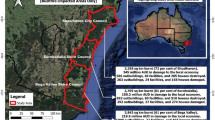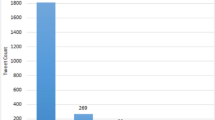Abstract
Social media plays a significant role in rapid propagation of information when disasters occur. Among the four phases of disaster management life cycle: prevention, preparedness, response, and recovery, this paper focuses on the use of social media during the response phase. It empirically examines the use of microblogging platforms by Emergency Response Organisations (EROs) during extreme natural events, and distinguishes the use of Twitter by EROs from digital volunteers during a fire hazard occurred in Australia state of Victoria in early February 2014. We analysed 7982 tweets on this event. While traditionally theories such as World System Theory and Institutional Theory focus on the role of powerful institutional information outlets, we found that platforms like Twitter challenge such notion by sharing the power between large institutional (e.g. EROs) and smaller non-institutional players (e.g. digital volunteers) in the dissemination of disaster information. Our results highlight that both large EROs and individual digital volunteers proactively used Twitter to disseminate and distribute fire related information. We also found that the contents of tweets were more informative than directive, and that while the total number of messages posted by top EROs was higher than the non-institutional ones, non-institutions presented a greater number of retweets.



Similar content being viewed by others
References
Abedin, B., Babar, A., & Abbasi, A. (2014). Characterization of the use of social Media in Natural Disasters: A systematic review. In Big Data and Cloud Computing (BdCloud), 2014 I.E. fourth international conference on (pp. 449–454).
Abedin, B., & Jafarzadeh, H. (2013). Attracting and retaining customers on Facebook business pages: A content analysis of an online discussion forum. International Journal of Technology Marketing, 8(3), 304–315.
Abedin, B. (2016). Diffusion of adoption of Facebook for customer relationship management in Australia: An exploratory study. Journal of Organizational and End User Computing (JOEUC), 28(1), 56–72.
Queensland police service-media and public affair branch (2011). Disaster management and social media – a case study, version 1.0.
Ahmad, A. (2011). Use of social media in disaster management. Second international conference on information systems (ICIS), paper 16.
Alam, S. L., & Walker, D. (2011). The public Facebook: A case of Australian government Facebook pages and participation. Sydney: ACIS.
Barnett, G. A. (2001). A longitudinal analysis of the international telecommunication network. American Behavioral Scientist, 44(10), 1638–1655.
Bird, D., Ling, M., & Haynes, K. (2012). Flooding Facebook-the use of social media during the Queensland and Victorian floods. Australian Journal of Emergency Management, 27(1), 27.
Butts, C. T. (2008). Social network analysis with sna. Journal of Statistical Software, 24(6), 1–51.
Cha, M., Haddidi, H., Benevenuto, F. & Gummadi, K. P. (2010). Measuring user influence in Twitter: The million follower fallancy. 4th International AAAI Conference on Weblogs and Social Media ICWSM, 2010 Washington, DC.
Chongsuvivatwong, V. (2008). Analysis of epidemiological data using R and epicalc. Thailand: Epidemiology Unit Prince of Songkla University.
Cobb, C., McCarthy, T., Perkins, A., Bharadwaj, A., Comis, J., Do, B., & Starbird, K. (2014). Designing for the deluge: Understanding & supporting the distributed, collaborative work of crisis volunteers. In proceedings of the 17th ACM conference on computer supported cooperative work & social computing, 888-899.
Crooks, A., Croitoru, A., & Stefanidis, A. (2013). #earthquake: Twitter as a distributed sensor system. Transactions in GIS, 17(1), 124–147.
Diaz-Uriarte, R., & Andres, S. A. D. (2006). Gene selection and classification of microarray data using random forest. BMC Bioinformatics, 7, 3.
Ehnis, C. & Bunker, D. (2012). Social media in disaster response: Queensland police service - public engagement during the 2011 floods. 23rd Australasian conference on information systems, 2012 Geelong, December 3-5.
Erfani, S. S., Blount, Y., & Abedin, B. (2016). The influence of health-specific social network site use on the psychological well-being of cancer-affected people. Journal of the American Medical Informatics Association, 23(3), 467–476.
Erfani, S. S., Abedin, B., & Blount, Y. (2017). The effect of social network site use on the psychological well-being of cancer patients. Journal of the Association for Information Science and Technology, 68(5), 1308–1322.
Eriksson, B., Barford, P., Sommers, J., & Nowak, R. (2010). A learning-basedapproach for IP geolocation. Kishnamurthy a and Plattner B (eds) passive and active measurment. Springer Lecture Notes in Computer Science, Berlin, 6032, 171–180.
Falls, A. D. (2013). Brand management in social media environments: An institutional theory perspective. University of Ulster: Doctoral dissertation.
Golan, G. J., & Himelboim, I. (2016). Can world system theory predict news flow on twitter? The case of government-sponsored broadcasting. Information, Communication & Society, 19(8), 1150–1170.
Heyde, S. V. D., Sonntag, J., Kaschek, D., Bender, C., Bues, J., Wachter, A., Timmer, J., Korf, U., & Beibarth, T. (2014). RPPanalyzer toolbox: An improved R package for analysis of reverse phase protein array data. BioTechniques, 57, 125–135.
Houston, J. B., Hawthorne, J., Perreault, M. F., Park, E. H., Goldstein Hode, M., Halliwell, M. R., & Griffith, S. A. (2015). Social media and disasters: A functional framework for social media use in disaster planning, response, and research. Disasters, 39(1), 1–22.
Hughes, A. L., & Palen, L. (2009). Twitter adoption and use in mass convergence and emergency events. In Proceedings of 6th international ISCRAM conference. Gothenburg: Sweeden.
Kavanaugha, A. L., Foxa, E. A., Sheetzb, S. D., Yanga, S., Lid, L. T., Soemakerc, D. J., Natsevf, A. & Xieg, L. (2011). Social media use by government: From the routine to the critical. The proceedings of the 12th annual Internaitonal conference on digital government research, June 12-15 College Park, MD, USA, 121-130.
Krishnamurthy, B., Gill, P., & Arlitt, M. (2008). A few chirps about twitter. Seattle, Washington: WOSN.
Lee, J., Agrawal, M., & Rao, H. R. (2015). Message diffusion through social network service: The case of rumor and non-rumor related tweets during Boston bombing 2013. Information Systems Frontiers, 17(5), 997–1005.
Lerman, K., & Ghosh, R. (2010). Information contagion: An empirical study of the spread of news on Digg and Twitter social networks. ICWSM, 10, 90–97
Mcnerthney, C. (2012). Shooting suspect visited bar before; gave off a ‘bad vibe. Seattle Pl.
Mendoza, M., Poblete, B., & Castillo, C. (2010). Twitter under crisis: Can we trust what we RT? 1st workshop on social media, July 25. Washington DC.
Merchant, R. M., Elmer, S., & Lurie, N. (2011). Integrating social media into emergency-preparedness efforts. New England Journal of Medicine, 365(4), 289–291.
Oh, O., Agrawal, M., & Rao, H. R. (2013). Community intelligence and social media services: A rumour theoretic analysis of tweets during social crises. MIS Quarterly, 37(2), 407–426.
Poblet, M., García-Cuesta, E., & Casanovas, P. (2017). Crowdsourcing roles, methods and tools for data-intensive disaster management. Information Systems Frontiers. https://doi.org/10.1007/s10796-017-9734-6.
Poese, I., Uhlig, S., Kaafar, A. M., Donnet, B., & Gueys, B. (2011). IP geolocation database. Unreliable? computer communication review, 41(2), 53–56.
Popoola, A., Krasnoshtan, D., Toth, A. P., Naroditskiy, V., Castillo, C., Meier, P., et al. (2013). Information verification during natural disasters. In Proceedings of the 22nd International Conference on World Wide Web (pp. 1029-1032). ACM. doi:10.1145/2487788.2488111.
Rosenberger, M., Lehrer, C., & Jung, R. (2016). Integrating data from user activities of social networks into public administrations. Information Systems Frontiers, 19(2), 1–14.
Sarcevic, A., Palen, L., White, J., Starbird, K., Bagdouri, M., & Anderson, K. (2012). Beacons of hope in decentralized coordination: Learning from on-the-ground medical twitterers during the 2010 Haiti earthquake. In Proceedings of the ACM 2012 conference on computer supported cooperative work (pp. 47-56). ACM. doi:10.1145/2145204.2145217
SBS Australia (2014). http://www.sbs.com.au/news/article/2014/02/09/no-let-victorias-fire-emergency.
Scott, W. R. (1995). Institutions and organizations. Thousand Oaks: Sage.
Simon, T., Goldberg, A., Aharonson-Daniel, L., Leykin, D., & Adini, B. (2014). Twitter in the cross fire - the use of social media in the Westgate mall terror attack in Kenya. PloS One, 9, 1–11.
Sinnappan, S., Farrell, C., & Stewart, E. (2010). Priceless tweets! A study on twitter messages posted during crisis: Black Saturday. In ACIS, 1–10 Dec 2010b. Brisbane: Australia.
Starbird, K., & Palen, L. (2011). Voluntweeters: Self organizing by digital volunteers in times of crisis. CHI, 2011, 1071–1080.
STieglitz, S., & Kruger, N. (2011). Analysis of Sentiments in Corporate Twitter Communication – A case study on an issue of Toyota. Proceedings of 22nd Australian Conference on Information Systems, November 30–December 2 2011 Sydney, Australia.
Sutton, J. N., Palen, L., & Shklovski, I. (2008). Backchannels on the front lines: Emergency uses of social media in the 2007 Southern California Wildfires (pp. 624–632). University of Colorado.
Tang, L., Ni, Z., Xiong, H., & Zhu, H. (2015). Locating targets through mention in twitter. World Wide Web, 18, 1019–1049.
Taylor, M., Wells, G., Howell, G., & Raphael, B. (2012). The role of social media as psychological first aid as a support to community resilience building. Australian Journal of Emergency Management, The, 27(1), 20–26.
Vieweg, S., Hughes, A. L., Starbird, K., & Palen, L. (2010). Microblogging during two natural hazards events: What twitter may contribute to the situational awareness. In CHI 2010. Atlanta Georgia: USA.
Wallerstein, I. (1974). The modern world system. New York: Academic Press.
Wang, B., Wang, C., Bu, J., Chen, C., Zhang, W. V., Cai, D., & He, X. (2013). Whom to mention: Expand the diffusion of tweets by @ recommendation on micro-blogging systems. In International world wide web conference, may 13–17, 2013. Rio De: Janeiro.
Whitelaw, T., & Henson, D. (2014). All that I’m hearing from you is white noise’: Social media aggregation in emergency response. Australian Journal of Emergency Management, 29, 48–51.
Yates, D., & Paquette, S. (2011). Emergency knowledge management and social media technologies: A case study of the 2010 Haitian earthquake. International Journal of Information Management, 31(1), 6–13.
Zao, S., et al. (2011). Human as real-time sensors of social and physical events: A case study of twitter and sport games (p. TR0620). Houston: Rice University Technical Report No.
Author information
Authors and Affiliations
Corresponding author
Rights and permissions
About this article
Cite this article
Abedin, B., Babar, A. Institutional vs. Non-institutional use of Social Media during Emergency Response: A Case of Twitter in 2014 Australian Bush Fire. Inf Syst Front 20, 729–740 (2018). https://doi.org/10.1007/s10796-017-9789-4
Published:
Issue Date:
DOI: https://doi.org/10.1007/s10796-017-9789-4




